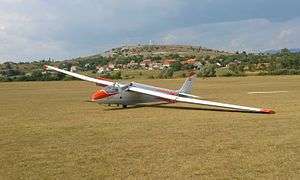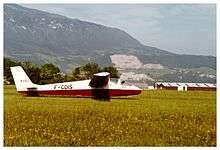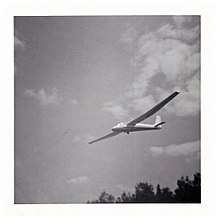Wassmer WA-30 Bijave
The Wassmer WA-30 Bijave is a French two-seat advanced training glider designed and built by Wassmer Aviation of Issoire.[1]
| WA-30 Bijave | |
|---|---|
 | |
| Role | Two-seat training glider |
| National origin | France |
| Manufacturer | Wassmer Aviation |
| First flight | 17 December 1958 |
| Number built | 285+ |
| Developed from | Wassmer WA-21 Javelot |
Design and development
The WA-30 Bijave is two-seat development of the Wassmer WA-21 Javelot II and the first Bijave flew on 17 December 1958 from Issoire Aerodrome.[1] The Bijave is a cantilever shoulder-wing monoplane with a welded steel tube fuselage covered with fabric and reinforced plastic.[1] The wing is made from wood, covered in birch forward of the spar and fabric to the rear, it has no flaps but is fitted with retractable perforated wooden airbrakes.[1] The pilot and passenger sit in tandem in an enclosed cockpit with individual transparent canopies.[1] The landing gear is a retractable monowheel, a wooden rubber-sprung skid under the nose and a steel tailskid.[1]


Specifications
Data from Jane's All the World's Aircraft 1973-74[1] The World's Sailplanes:Die Segelflugzeuge der Welt:Les Planeurs du Monde Volume II[2]
General characteristics
- Crew: 2
- Length: 9 m (29 ft 6 in)
- Wingspan: 16.85 m (55 ft 3 in)
- Height: 2.74 m (9 ft 0 in)
- Wing area: 19.2 m2 (207 sq ft)
- Aspect ratio: 15
- Airfoil: Root: NACA 63821, Tip: NACA 63415
- Empty weight: 295 kg (650 lb)
- Gross weight: 500 kg (1,102 lb)
Performance
- Stall speed: 60 km/h (37 mph, 32 kn)
- Never exceed speed: 200 km/h (120 mph, 110 kn)
- Rough air speed max: 150 km/h (93.2 mph; 81.0 kn)
- Aerotow speed: 130 km/h (80.8 mph; 70.2 kn)
- Winch launch speed: 100 km/h (62.1 mph; 54.0 kn)
- Terminal velocity: with full airbrakes 190 km/h (118 mph; 103 kn)
- g limits: +5.33 -2.13 at 220 km/h (136.7 mph; 118.8 kn)
- Maximum glide ratio: 27 at 85 km/h (52.8 mph; 45.9 kn)
- Rate of sink: 0.75 m/s (148 ft/min) at 78 km/h (48.5 mph; 42.1 kn)
- Wing loading: 26 kg/m2 (5.3 lb/sq ft)
References
| Wikimedia Commons has media related to Wassmer WA-30 Bijave. |
- Notes
- Taylor, John W. R., ed. (1973). Jane's All the World's Aircraft 1973-74. London, United Kingdom: Jane's Yearbooks. ISBN 0-354-00117-5.
- Shenstone, B.S.; K.G. Wilkinson (1963). The World's Sailplanes:Die Segelflugzeuge der Welt:Les Planeurs du Monde Volume II (in English, French, and German) (1st ed.). Zurich: Organisation Scientifique et Technique Internationale du Vol a Voile (OSTIV) and Schweizer Aero-Revue. pp. 88–89.
- Bibliography
- Shenstone, B.S.; K.G. Wilkinson (1963). The World's Sailplanes:Die Segelflugzeuge der Welt:Les Planeurs du Monde Volume II (in English, French, and German) (1st ed.). Zurich: Organisation Scientifique et Technique Internationale du Vol a Voile (OSTIV) and Schweizer Aero-Revue. pp. 88–89.
- Taylor, John W.R., ed. (1973). Jane's All the World's Aircraft 1973-74. London, United Kingdom: Jane's Yearbooks. ISBN 0-354-00117-5.